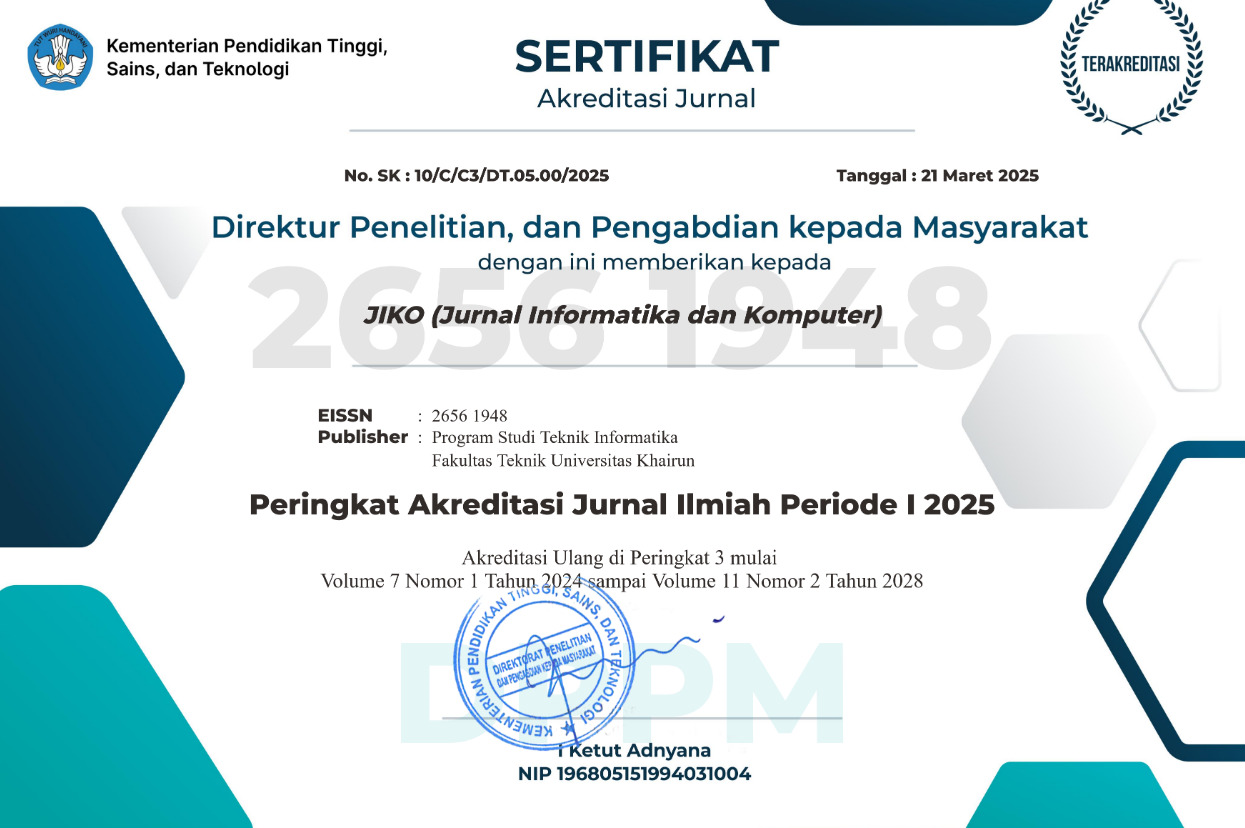DETECTION OF THE SIZE OF PLASTIC MINERAL WATER BOTTLE WASTE USING THE YOLOV5 METHOD
Abstract
The use of plastic bottles for various needs is increasingly massive, especially in consumption needs such as mineral water bottles. The use of plastic bottles is used to reduce costs and be effective in maintaining the quality of mineral water, but its impact can affect natural conditions if not managed properly. Plastic bottle waste if left buried in the ground will have difficulty expanding, which can cause environmental pollution. Therefore, we can take advantage of technology to sort plastic bottle waste using a camera based on the size of plastic bottles. Differentiating the size of bottles aims to distinguish the economic value when exchanged at the waste bank. This technology utilizes object detection and recognition functions such as the YOLO (You Only Look Once) method. YOLO is a detection method that is a development of the CNN (Convolutional Neural Network) algorithm. By using YOLOv5, we can detect objects in the form of plastic bottle waste of various different sizes. To maximize object detection according to size, data annotation is done by creating a Bounding Box on each dataset according to its size. The test was carried out with several different distance configurations including 40cm, 80cm and 1m. Detection results using YOLOv5 produce up to 84% accuracy in real-time.
Full Text:
PDFReferences
O. E. Karlina and D. Indarti, “Pengenalan Objek Makanan Cepat Saji Pada Video Dan Real Time Webcam Menggunakan Metode You Look Only Once (Yolo),†J. Ilm. Inform. Komput., vol. 24, no. 3, pp. 199–208, 2019, doi: 10.35760/ik.2019.v24i3.2362.
L. C. Prita1, “ALAT PEMILAH SAMPAH ORGANIK ANORGANIK DAN LOGAM SECARA OTOMATIS MENGGUNAKAN SENSOR PROXIMITY,†vol. 2, no. 10, p. 6, 2021.
M. Sajid and N. T. Medagedara, “A New Paradigm for Waste Classification Based on YOLOv5,†vol. 8, no. 4, pp. 9–17, 2021.
L. Palupi, E. Ihsanto, and F. Nugroho, “Analisis Validasi dan Evaluasi Model Deteksi Objek Varian Jahe Menggunakan Algoritma Yolov5,†Univ. Mercu Buana, Jakarta Jl. Menteng Raya No, vol. 5, no. 1, 2023, doi: 10.47065/josh.v5i1.4380.
L. Setiana Riva, “Deteksi Penyakit Tanaman Cabai Menggunakan Algoritma YOLOv5 Dengan Variasi Pembagian Data,†J. Pengemb. IT, vol. 8, no. 3, pp. 248–254, 2023.
B. Putra, G. Pamungkas, B. Nugroho, and F. Anggraeny, “Deteksi dan Menghitung Manusia Menggunakan YOLO-CNN,†J. Inform. dan Sist. Inf., vol. 02, no. 1, pp. 67–76, 2021.
C. M. Annur, “10 Jenis Sampah yang Paling Banyak Ditemukan di Pesisir Pantai Global (2021),†databoks.katadata, 2023. https://databoks.katadata.co.id/datapublish/2023/06/09/puntung-rokok-hingga-botol-plastik-ini-jenis-sampah-paling-banyak-ditemukan-di-pesisir-pantai-dunia
J. Zophie and H. Himawan Triharminto, “9. Implemetasi Algoritma You Only Look Once (YOLO) menggunakan Web Camera untuk Mendeteksi Objek Statis dan Dinamis,†TNI Angkatan Udar., vol. 1, no. 1, 2023, doi: 10.62828/jpb.v1i1.50.
K. A. Baihaqi and C. Zonyfar, “Deteksi Lahan Pertanian Yang Terdampak Hama Tikus Menggunakan Yolo v5,†Syntax J. Inform., vol. 11, no. 02, pp. 1–9, 2022.
E. R. Justitian, I. Y. Purbasari, and F. T. Anggraeny, “Perbandingan Akurasi Deteksi Kelelahan pada Pengendara Menggunakan YOLOv3-Tiny YOLOv4-Tiny,†J. Inform. dan Sist. Inf., vol. 3, no. 1, pp. 21–30, 2022, doi: 10.33005/jifosi.v3i1.440.
M. Dio Riza Pratama, B. Priyatna, S. S. Hilabi, and A. L. Hananto, “Deteksi Objek Kecelakaan Pada Kendaraan Roda Empat Menggunakan Algoritma YOLOv5,†J. Ilm. Sist. Informas, vol. 12, no. 2, pp. 15–26, 2022.
D. Wahiddin, “Klasifikasi Kadar Hidrasi Tubuh Berdasarkan Warna Urine dengan Metode Ekstraksi Fitur Citra dan Euclidean Distance,†Techno Xplore J. Ilmu Komput. dan Teknol. Inf., vol. 5, no. 1, pp. 16–20, 2020, doi: 10.36805/technoxplore.v5i1.887.
D. G. Arwindo, E. Y. Puspaningrum, and Y. V. Via, “Identifikasi Penggunaan Masker Menggunakan Algoritma CNN YOLOv3-Tiny,†Pros. Semin. Nas. Inform. Bela Negara, vol. 1, pp. 153–159, 2020, doi: 10.33005/santika.v1i0.41.
J. Redmon and A. F. , Santosh Divvala, Ross Girshick, “You Only Look Once: Unified, Real-Time Object Detection Joseph,†ACM Int. Conf. Proceeding Ser., 2018, doi: 10.1145/3243394.3243692.
Sik-Ho Tsang, “YOLOv5 for Object Detection,†medium.com, 2023. https://sh-tsang.medium.com/brief-review-yolov5-for-object-detection-84cc6c6a0e3a
J. Indra, “Penerapan Artificial Neural Network Untuk Klasifikasi Fertilitas Telur Itik Menggunakan Raspberry Pi,†Buana Ilmu, vol. 3, no. 1, 2018, doi: 10.36805/bi.v3i1.460.
P. Henderson and V. Ferrari, “End-to-end training of object class detectors for mean average precision,†Lect. Notes Comput. Sci. (including Subser. Lect. Notes Artif. Intell. Lect. Notes Bioinformatics), vol. 10115 LNCS, pp. 198–213, 2017, doi: 10.1007/978-3-319-54193-8_13.
K. Oksuz, B. C. Cam, E. Akbas, and S. Kalkan, “Localization recall precision (LRP): A new performance metric for object detection,†Lect. Notes Comput. Sci. (including Subser. Lect. Notes Artif. Intell. Lect. Notes Bioinformatics), vol. 11211 LNCS, pp. 521–537, 2018, doi: 10.1007/978-3-030-01234-2_31.
D. Iskandar Mulyana and M. A. Rofik, “Implementasi Deteksi Real Time Klasifikasi Jenis Kendaraan Di Indonesia Menggunakan Metode YOLOV5,†J. Pendidik. Tambusai, vol. 6, no. 3, pp. 13971–13982, 2022, doi: 10.31004/jptam.v6i3.4825.
L. Suroiyah, Y. Rahmawati, and R. Dijaya, “Facemask Detection Using Yolo V5,†J. Tek. Inform., vol. 4, no. 6, pp. 1277–1286, 2023, doi: 10.52436/1.jutif.2023.4.6.1043.
P. Mustamo, “Object detection in sports: TensorFlow Object Detection API case study,†no. January, pp. 1–43, 2018.
R. Padilla, S. L. Netto, and E. A. B. Da Silva, “A Survey on Performance Metrics for Object-Detection Algorithms,†Int. Conf. Syst. Signals, Image Process., vol. 2020-July, pp. 237–242, 2020, doi: 10.1109/IWSSIP48289.2020.9145130.
DOI: https://doi.org/10.33387/jiko.v7i2.8535
Refbacks
- There are currently no refbacks.











